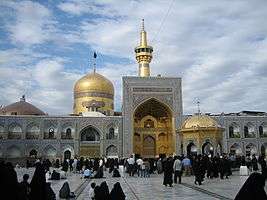Mausoleum of Ruhollah Khomeini
|
| |
| Location | Tehran, Iran |
|---|---|
| Designer | Parviz Moayyed |
| Type | Mausoleum |
| Beginning date | 19 July 1989 |
| Completion date | 2 June 1992 |
| Dedicated to | Ruhollah Khomeini |
| Website | www.harammotahar.ir |
The Mausoleum of Ayatollah Khomeini houses the tomb of Ruhollah Khomeini and his family – his wife Khadijeh Saqafi and his second son Ahmad Khomeini – and some political figures like Hassan Habibi, Ali Sayad Shirazi, Sadeq Tabatabaei, and Marzieh Hadidchi. It is located to the south of Tehran in the Behesht-e Zahra (the Paradise of Zahra) cemetery. Construction commenced in 1989 following Khomeini's death on June 3 of that year. It is still under construction, but when completed will be the centerpiece in a complex spread over 5,000 acres (20 km2),[1] housing a cultural and tourist center, a university for Islamic studies, a seminary, a shopping mall, and a 20,000-car parking lot.[2] [1] The Iranian government has reportedly devoted US$2 billion to this development.[2]
The site is a place of pilgrimage for followers of Khomeini. It is used symbolically by government figures, and is on occasion visited by foreign dignitaries.[3] Every year, the Khomeini's death anniversary were marked on 4 June at the mausoleum which is attend by governmental officials, foreign ambassadors and people. Khomeini's grandson Ayatollah Seyyed Hassan Khomeini is in charge of caring for the mausoleum.[4] The Haram-e Motahhar Metro Station is the closest metro station to the mausoleum.
Specifications
.jpg)
The architect of the tomb was Mohammed Tehrani.[1] The exterior of the shrine complex is a highly recognizable landmark. It has a gold dome sitting on a high drum, surrounded by four free-standing minarets. The shrine is surrounded by a large rectangular plaza which has been designed to hold vast numbers of visitors. With its size, inclusion of a qibla wall and a maqsura, the tomb resembles a mosque, but has been called an Hussainia.[5]
Inside, Khomeini's sarcophagus is centrally placed under the gilded dome. The dome sits above a transition zone with two layers of clerestories, decorated with stained glass depicting tulips (an Iranian symbol of martyrdom). The dome is supported by eight large marble columns that circle the sarcophagus, that together with other smaller columns support the space frame ceiling. The ceiling is also punctuated by clerestories. The floor and wall surfaces are made of polished white marble. The floor is covered with fine carpets.
Non-Muslims are allowed inside the complex.[6]
Controversies
On June 20, 2009, a suicide bomb attack reportedly occurred near the site of the Mausoleum, according to Iranian state-controlled media.[7] The attack did not damage the mausoleum.
Gallery
.jpg) Interior view of the mausoleum
Interior view of the mausoleum Mausoleum in 1990 in Khomeini's 1st death anniversary
Mausoleum in 1990 in Khomeini's 1st death anniversary_by_night2.jpg) Mausoleum in night
Mausoleum in night.jpg) Mausoleum under construction in 2015
Mausoleum under construction in 2015.jpg) Zarih of the mausoleum
Zarih of the mausoleum.jpg) Place of speech of Ali Khamenei during Khomeini's death anniversaries
Place of speech of Ali Khamenei during Khomeini's death anniversaries.jpg) Imam Khomeini museum
Imam Khomeini museum- Khomeini's grave
.jpg) The mausoleum in 2007
The mausoleum in 2007 Masoleum's view in 2010
Masoleum's view in 2010 Mausoleum's view in night
Mausoleum's view in night Khomeini's signature symbol outside of the complex
Khomeini's signature symbol outside of the complex.jpg) Masoleum's interior view in 2015
Masoleum's interior view in 2015.jpg) Khadijeh Saqafi, wife of Khomeini's grave
Khadijeh Saqafi, wife of Khomeini's grave
See also
| Wikimedia Commons has media related to Mausoleum of Ruhollah Khomeini. |
- Behesht-e Zahra
- Ruhollah Khomeini
- Reza Shah's mausoleum
- Holiest sites in Islam (Shia)
- Imām Ridhā Mosque
- Fatimah al-Ma'sūmah Mosque
- Shāh Abdol Azīm Mosque
- History of Persian domes
References
- 1 2 3 Khomeini Tomb
- 1 2 Khomeini's Tomb Attracts Pilgrims - New York Times
- ↑ FarsiNet News - News related to Iran, Iranians and Persians - June 1997
- ↑ Khomeini's grandson speaks out on Iran military | France 24
- ↑ Kaplan, Robert, Ends of the Earth, A journey at the Dawn of the 21st Century, Random House, 1996, p.179
- ↑ Mehr-e-Khavar Iran In Brief
- ↑ Suicide bomber attacks Khomeini shrine in Iran


